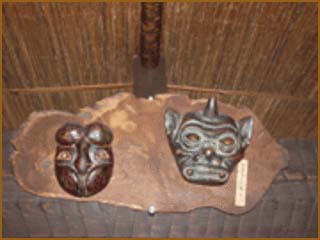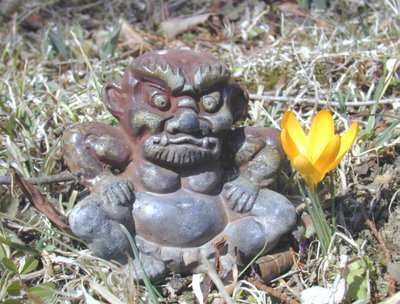. Onipedia - 鬼ペディア - Oni Demons - ABC-List - .
::::::::::::::::::::::::::::::::::::::::::::::::::::::::::::::::::::::::::::::::::::::::::::::::::::::::::::::::::::::::::::::::::::::::::::::::::::::::::::::::::::::::::::::
Amanojaku 天の邪鬼 / 天邪鬼 Legends - Amanjaku - "heavenly evil spirit "
- 天探女(あまのじゃく) - Amanosagume / 天探女(あめのさぐめ)/ 天佐具売 Amenosagume

Amanjaku no hoshitori あまんじゃくの星とり
Amanjaku tries to grab the stars from the sky.
He collects all the boulders and even grave stones in the area of Mimasaka to built a high tower to reach up there . . . but ooohhh . . . just when he is about to grab the first star the boulders give way and fall to the ground . . . where they still are lying around in a phantastic formation.

Amanjaku no Kasane-Iwa in Ohaga 大垪和の「天の邪鬼の重ね岩」
rock formation in Ohaga
. 大垪和の天の邪鬼伝説 -Amanjaku Legend of Ohaga, Okayama .
- Introduction -
.......................................................................
. Jaki 邪鬼の伝説 "Evil Spirit" Legends .
. Tsugaru no oniko, oni-ko 津軽の鬼子 .
Oniko means a demon in Tsugaru dialect.
Oniko, enshrined on top of a Torii gate, is worshipped in about 30 shrines over 7 cities and towns in northwest Tsugaru County.
::::::::::::::::::::::::::::::::::::::::::::::::::::::::::::::::::::::::::::::::::::::::::::::::::::::::::::::::::::::::::::::::::::::::::::::::::::::::::::::::::::::::::::::
Amanojaku is a small demon-like creature who can provoke a person’s deepest and darkest desires, instigating him to do evil deeds.
In the fairytale “Urikohime” 瓜子姫, a girl born from a gourd was raised by an elderly couple, sheltering her from evil. One day she let Amanojaku inside the house and he killed her, using her skin to impersonate her.

............................................................................ Aomori 青森県
Urikohime 瓜子姫 / Urihimeko 瓜姫子
アマノサグ Amanosagu from Aomori
tells the story of Urihime 瓜姫子 from 五戸町 Gonohe Town.
. . . The Amanojaku impersonating the Girl was to be wed. At the Wedding Party the "Girl" ate all the food and was thrown out of the house as a bakayome 馬鹿嫁 useless, dumb bride.

- reference -
. Legends about Plants 植物と伝説 shokubutsu to densetsu .
............................................................................ Ishikawa 石川県
ある日、婆ちゃんが川上から流れてきた瓜を拾って帰った瓜の中に姫がいた。瓜姫小女郎と名づけられた姫が機織をしていると、天の邪鬼がやってきて姫を連れ出し、木につるして自分が姫に化けた。天からの迎えが来たときに、正体が天の邪鬼であることがわかり、天車を持ってきた人は天の邪鬼をひきずり落として踏み殺し、本物の姫を乗せていった。
.................................................................................................................................................................

The amanojaku is commonly held to be derived from
Amanosagume (天探女), a wicked deity in Shintō myth, which shares the amanojaku's contrary nature and ability to see into a person's heart, "a very perverted demon".
The creature has also entered Buddhist thought, perhaps via syncretism with the yasha, where it is considered an opponent of Buddhist teachings. It is commonly depicted as being trampled on and subdued into righteousness by Bishamonten or one of the other Shitennō.
In this context it is also called a jaki (邪鬼).
© More in the WIKIPEDIA !
天探女(あめのさぐめ)は、天稚彦に仕えるような描写で日本神話に登場する女神。天佐具売にも作る(『古事記』)。天邪鬼(あまのじゃく)の原像とされる。
- - - More in the WIKIPEDIA !
- quote -
Amenosagume
A vassal kami to Amewakahiko. In order to question Amewakahiko regarding his delayed return to Heaven, Amaterasu and Takamimusuhi sent a pheasant as observer and messenger. Amenosagume saw the pheasant observing Amewakahiko from a tree outside the gate, and thinking its cry an evil omen, urged Amewakahiko to shoot the bird. Amewakahiko shot the pheasant with an arrow he had received from the heavenly kami (amatsukami), but he was himself killed as the arrow fell back to earth.
The term sagume means a fortune-teller, and it has been said that the demonic Buddhist figures "Amanojaku" derive from the name of this kami. An "alternate writing" quoted in Nihongi describes Amenosagume as an "earthly deity" (kunitsukami).
- source : Kokugakuin, Mori Mizue, 2005 -
..............................................................................................................................................

Amanojaku at temple Gansenji, Kyoto
岩船寺の三重の塔を支える天邪鬼

amanojaku no mayoke no o-mamori 天邪鬼の魔除のお守り
amulet with Amanojaku

Temple Gansenji 岩船寺 Gansen-Ji - 京都府木津川市加茂町岩船上ノ門43
. O-Mamori お守り Amulets and Talismans .
::::::::::::::::::::::::::::::::::::::::::::::::::::::::::::::::::::::::::::::::::::::::::::::::::::::::::::::::::::::::::::::::::::::::::::::::::::::::::::::::::::::::::::::
............................................................................ Hyogo 兵庫県
Amanojaku no Chikaramizu 天邪鬼の力水 Power-giving water
Hyogo prefecture, 笠形山 (龍ヶ滝~あまのじゃく)

- reference -
.
muen ムエン - kawasemi カワセミ
ムエンとはカワセミの事で別名ドジョウホリとも言う。前世は、綺麗だが天邪鬼で反対の事ばかりする娘だった。父親はわざと「死んだら山に埋めず川に流してくれ」と遺言する。娘は遺言通りにした後父の真意を知って後悔し、今も川の上を飛び、地に深い穴を掘る。
::::::::::::::::::::::::::::::::::::::::::::::::::::::::::::::::::::::::::::::::::::::::::::::::::::::::::::::::::::::::::::::::::::::::::::::::::::::::::::::::::::::::::::::

CLICK for more photos !
::::::::::::::::::::::::::::::::::::::::::::::::::::::::::::::::::::::::::::::::::::::::::::::::::::::::::::::::::::::::::::::::::::::::::::::::::::::::::::::::::::::::::::::

Amanojaku Yokai by Matthew Meyer
Amanojaku are a fun yokai because they are so downright nasty. I mean, there are so many kinds of yokai which are nasty to a point, but the amanojaku is so evil and so unpleasant that they rival tengu and oni for all-time villains of Japanese lore. They kind of remind me of gremlins or goblins, in that they are nasty, wicked, and yet in a way somewhat weak and pathetic.
It’s not terribly rare to see Buddhist statues in Japan of a great god stamping on demons, using them as a pedestal. Those are usually representations of Bishamonten—chief of the four heavenly kings and a sort of god of war in Japanese Buddhism. As the amanojaku are symbols of pure evil, he is depicted as crushing and defeating them, in true warrior-king fashion. It’s enough to make you feel a bit sorry for them, as they are rather small and pathetic under his boot… but when you read the stories about how nasty they are, that pathetic facade quickly fades away!
- source : matthewmeyer.net/blog -
::::::::::::::::::::::::::::::::::::::::::::::::::::::::::::::::::::::::::::::::::::::::::::::::::::::::::::::::::::::::::::::::::::::::::::::::::::::::::::::::::::::::::::::
There are some legends where Amanojaku imitates the call of a rooster as a sign of morning and his opponent was deceived in thinking his time was up.
............................................................................ Gifu 岐阜県
上宝村 Kamitakaramura, 双六 Sugoroku
Kobo Daishi 弘法大師 and Zaimoku-Iwa 材木岩 - Timber Rocks
Once Kobo Daishi came to Sugoroku village. He made a bet with the local Amanojaku that he would build a temple hall in one night. But the Amanojaku imitated the call of a rooster as a sign of morning and Kobo Daishi was deceived in thinking his time was up.
Kobo Daishi got so angry that he turned all the wood for the temple hall into stones and boulders. This is the origin of natural stone formation, looking like pieces of wood :

Zaimoku-Ishi 材木石 / Zaimoku-Iwa 材木岩 - Timber Rocks
- A similar legend is told in Miyagi about
. Hida no takumi 飛騨の工匠 master carpenter from Hida .
trying to built 一夜で不動堂 a Fudo Hall in one night.
.......................................................................
岩波橋 Iwanamibashi and Amanojaki 天の邪気 (あまのじゃき)
At 双六の岩波橋 the bridge Iwanamibashi at Sugoroku there is a rock formation looking like a game board for the game Sugoroku ( 双六の盤).
Once some Amanojaku collected rocks from a mountain in the West to make a board to play Sugoroku. The one who lost the game got angry and threw the bord far away, where it hit a stone cliff, dissolved into many small stones and is still now at the side of the river, called 賽の淵 Sai no Fuchi.
This is the origin of the name of this small village, Sugoroku.
. sugoroku 双六 Sugoroku board game .
.......................................................................
天邪鬼と天人 Amanojaku to Tenjin (Tennin)
This is another version of the above, where Amanojaku and Tenjin played a game of Sugoroku. When Amanojaku cheated to win, Tenjin got angry and threw the board away. The dice they had used became the stone formation Sai ga Fuchi サイが渕 (same as the Sai no Fuchi above).
Once a gropu of professional gamblers made fun of this story and peed on the rocks.
Suddenly the weather turned wild, it began to snow and all the crops of the year were lost.
The gamblers were arrested, tortured and finally died of mental disorders.
.......................................................................

source : hirajin.com/gallery
天邪鬼面 Masks of Amanojaku from Gifu
............................................................................ Kagoshima 鹿児島県
志布志市 Shibushi
Otohime 乙媛様 Princess Otohime, "Sound Princess"
If people stay over night at the island 枇榔島 Birojima, they can hear a sound like music at night. It sounds like someone playing the 琵琶 biwa lute, singing very noisily as if rocks were falling down. The trees of the island seem to groan in rythm with the noise.
The daugher of the Emperor 天智天皇 Tenji Tenno (626 - 671) was called "Otohime" and legend knows that she made this island in one night. The bad things happening there are all her deeds. She had been made to float in the sea but created this island to live on. Then she tried to build a stone path to the mainland in one night.
But an Amanojaku imitated the call of a rooster as a sign of morning and spoiled her road building.
To our day there seems to be a path of rocks leading from the island toward the main land.
............................................................................ Nagano 長野県
木曽郡 Kiso district 上松町
天の邪鬼が大きな山を背負って夜中に上松の小脇まで来た。ところがそこで朝になってしまったので、そこに背負っていた山を置いて、奥山へ飛び上がっていた。その山が、小脇にある丸山だという。
............................................................................ Nagasaki 長崎県
あまんしゃぐめ Amanjagume
あまんじゃくめが朝までにけぇまぎ崎を築いたら人間を皆喰うといったところ、たつたの番匠が鶏のまねをした。
.
gaataro がぁたろ a kappa and あまんしゃぐめ
あまんじゃくめとたつたの番匠が橋の渡しあいをした。たつたの番匠は3000人の藁人形を作り、使役した。あまんじゃくめは鶏の鳴きまねをして、中止になった。人形は捨てられがぁたろになった。
.
昔、田畑の出来はよく、稲は刈らなくても手招きをすれば寄ってきて自然に取り入れが出来た。けれどもあまんじゃくめが、稲・麦・黍・もろこしを根からすごきあげたので、実は上にだけ残った。大豆だけは手が痛かったのですごけなかった。
.
昔、あまんじゃくめが草の種を袋に入れて、百姓の困るように田畑へ蒔いて歩いた。ところが新城の辺で種をうちかえしたので、あの辺りは田畑に草が多い。
............................................................................ Tottori 鳥取県
中山町 Nakayama
お婆さんが川で洗濯をしていると瓜が流れてきたので拾って帰った。すると瓜の中から女の子が生まれ、瓜姫と名づけて育てるが、天邪鬼が悪さをして瓜姫になりかわってしまう。瓜姫が花嫁さんになるときに、鳥の知らせでそれがばれる。
.......................................................................
気高郡 Ketaka district 末恒村
あまんじゃく Amanjaku
.
あまのじゃくがモッコに一荷土を運んで来たが、モッコの緒が切れて土がこぼれたので、そのままにして逃げた。それが大路山と雲山にある山にある。
.
昔御熊の神様が真崎の鼻から隠岐国まで石材で、一夜のうちに橋を架けようとしていたところ、沖の島の沖合まできた所で、鶏が羽ばたきをして鳴いた。仕方ないので仕事を打ち切ったが、それはあまのじゃくの仕業であった。その罪で、あまのじゃくは沖の島の上に石と化した。あまのじゃく岩という。
............................................................................ Toyama 富山県
魚津市 Uozu town
庚申が出てきたとき、世の中に悪者がたくさんいたためそれを退治した。またに挟んでいるのは天の邪鬼という悪者であり、それが人間を食べるので動けないように挟んでいるのである。
............................................................................ Wakayama 和歌山県
Hashigui-iwa 橋杭岩 Hashigui Rocks "Bridge Post Rocks"
- quote -
Hashigui Rocks are 40 large and small rocks extending across the sea 850 m from Hashigui, Kushimoto-cho to Oshima Island.
Legend has it that once upon a time Kobo Daishi Kukai laid a wager with Amanojaku (heavenly evil spirit) if he could build a bridge to Oshima Island before dawn. Seeing that Kukai would win, Amanojaku cheated Kukai by mimicking a rooster call. Hearing this, Kukai thought the day broke and gave up completing the bridge. Consequently only the posts remained.

At low tide, the path to Benten Island in the middle of the way appears, which amuses tourists. The rocks are located in Yoshino-Kumano National Park. Hashigui Rocks are designated as a national Natural Treasure and selected as one of Japan’s 100 Fine Sunrise Spots.
- source : nippon-kichi.jp -
............................................................................ Yamagata 山形県
東田川郡 Higashitagawa
Kobo Daishi 弘法大師 and Amanojaku
Once Kobo Daishi walked along the river Mogamigawa 最上川 when a leaf of the butterbur 蕗の葉 came floating downriver, shining all the way.
When he took a closer look, he saw 大日如来の梵字 the Sanskrit letters for Dainichi Nyorai in the leaf. Another leaf followed and then one more and one more . . . There must be something special upstream, he thought and climbed higher. When he came to the pool below the Waterfall of Yudonoyama, an Amanjaku tried to pick up the Sanskrit letters floating down the waterfall and wrapping them into leaves of the butterbur.
Kobo Daishi banned this Amanojaku to the top of 仙人岳 Mount Senningatake.

CLICK for more photos !
湯殿山の滝壷 the pool below the Waterfall of Yudonoyama
. Dainichi Nyorai 大日如来 .
. sennin 仙人と伝説 Legends about Immortals .
.......................................................................
上山市 Kaminoyama
At the top of Mount Sarukurayama 猿倉山 there are a lot of boulders.
Once there were many monkeys, collecting boulders to make a store house (kura 倉) - says one legend.

source : blog.goo.ne.jp/tokiba65
- Another legend knows this:
Once upon a time
The deities wanted to build a mountain temple in one night. But then the Amanojaku imitated the call of a rooster as a sign of morning and the deities were deceived in thinking their time was up.
The stones from their attempt are still lying there.
.......................................................................
東田川郡 Higashi Tagawa district
Kobo Daish walkind up Mogamigawa
弘法大師が最上川のほとりを歩いていると、川上から蕗の葉が流れてきて、その下から光が差していた。杖で葉をかき分けると大日如来の梵字が現れた。次から次へと流れてくる葉が皆そうなので、川上に大日如来がいるに違いないと川を上ると、湯殿山の滝壷で天邪鬼が滝壷に浮かんでくる梵字を隠そうと蕗の葉をかぶせていたので、弘法大師は天邪鬼を仙人岳に封じた。
..............................................................................................................................................
. tansu 箪笥 / 簞笥 -- たんす chest of drawers, Kommode .
福島県 Fukushima - Amanojaku アマノジャク
地蔵様は、嫁に来手の無い小男の庄太のことを心配し、良縁をまとめてやった。嫁入りの夜、地蔵は輩下の貉を挑発し、川に橋をかけて箪笥と長持ちを渡そうとしたが、アマノジャクのせいで橋は完成しなかった。
..............................................................................................................................................
- source : 妖怪 データベース yokai database - reference -
. Kobo Daishi, Kukai 弘法大師 空海 - . (774-835) .
::::::::::::::::::::::::::::::::::::::::::::::::::::::::::::::::::::::::::::::::::::::::::::::::::::::::::::::::::::::::::::::::::::::::::::::::::::::::::::::::::::::::::::::

CLICK for more photos !
::::::::::::::::::::::::::::::::::::::::::::::::::::::::::::::::::::::::::::::::::::::::::::::::::::::::::::::::::::::::::::::::::::::::::::::::::::::::::::::::::::::::::::::
岡山県. 美作のあまんじゃく Okayama, Mimasaka - More tales of Amanojaku tba
長崎県. 壱岐のあまんしゃぐめ - Nagasaki, Iki island
- source : manga nihon mukashibanashi -
::::::::::::::::::::::::::::::::::::::::::::::::::::::::::::::::::::::::::::::::::::::::::::::::::::::::::::::::::::::::::::::::::::::::::::::::::::::::::::::::::::::::::::::
- - - - - H A I K U - - - - -
| 天の邪鬼 春の日差しに 悪さなし Amanojaku haru no hisashi ni warusa nashi  you can't do harm in the spring sunshine - pretty monsterlin |
..............................................................................................................................................
天の邪鬼夜半の風鈴玩ぶ
天の邪鬼雁がねのこゑ倣ふらし
相生垣瓜人 Aioigaki Kajin (1898 - 1985)
.......................................................................
あたたかや身より離るる天邪鬼
希伊子
口開かぬ浅蜊ごときは天の邪鬼
北見さとる
天邪鬼にいちばん見えて蝉の穴
吉田紫乃
天邪鬼の口の中まで黴びたまふ
佐藤浩子
天邪鬼を以て任じて暑に対す
下村梅子
山焼かれ行きどころなき天邪鬼
丸山嵐人
日没の稲架をゆさぶる天邪鬼
市原光子
春暁の腹やはらかな天邪鬼
高室有子
父の日や生れついての天邪鬼
三宅郷子
蝶生まれ心さわぎの天の邪鬼
鍵和田[ゆう]子
裸では寒い秋雨天邪鬼
川崎展宏
雑木山ひとつてのひらの天邪鬼
金子皆子
鵙ないて天邪鬼ゐる山の寺
近藤紀代女
::::::::::::::::::::::::::::::::::::::::::::::::::::::::::::::::::::::::::::::::::::::::::::::::::::::::::::::::::::::::::::::::::::::::::::::::::::::::::::::::::::::::::::::

. Japanese Legends - 伝説 民話 昔話 – ABC-List .
. Onipedia - 鬼ペディア - Oni Demons - ABC-List - .
. Japan - Shrines and Temples - ABC .
[ . BACK to DARUMA MUSEUM . TOP . ]
[ . BACK to WORLDKIGO . TOP . ]
- - #gokurakuamanojaku #amanojakulegends -
::::::::::::::::::::::::::::::::::::::::::::::::::::::::::::::::::::::::::::::::::::::::::::::::::::::::::::::::::::::::::::::::::::::::::::::::::::::::::::::::::::::::::::::

1 comment:
niwatori 鶏と伝説 Legends about the rooster, cock, chicken
tori 酉 rooster (chicken, cock)
kake かけ(鶏) rooster, niwatori 鶏 chicken
.
https://heianperiodjapan.blogspot.jp/2017/09/niwatori-rooster-cook-chicken-legends.html
.
Post a Comment